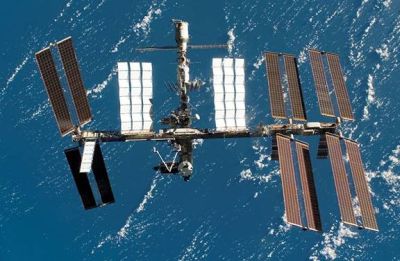24 April 2008

The image shows the International Space Station (ISS), imaged from the Space Shuttle Endeavor.
Image credit: NASA
Flying at an altitude of about 340 km, aboard the International Space Station (ISS), astronauts enjoy most of their free time beholding home, our planet Earth. NASA has declared that everyday onboard the orbiting outpost is Earth Day!
The ISS astronauts found the view of Earth as an indescribable, awe-inspiring constant. For six months, an ISS astronaut circles Earth every 90 minutes, at a speed of approximately 28,000 km per hour.
The station provides a unique vantage point from which to observe, monitor and even discover Earth. A high quality window for visual observations, located in the U.S. Laboratory, Destiny, was particularly designed for that purpose.
"Astronaut photographs of Earth are taken from the human perspective from space,” said Sue Runco, Earth remote sensing scientist at NASA’s Johnson Space Center. “Just the fact of seeing Earth as another human sees it, is why people often can relate to them much greater than they can to satellite imagery."
Astronauts study meteorology, geology, oceanography and environmental science in preparation of their mission to maximize their observations of Earth. They use a variety of professional digital cameras and lenses to picture Earth, and, more recently, high-definition video.
A ground-based science team helps the crews identify upcoming photo opportunities. The scientists send daily messages to the crew, including information on, and the locations of the targets. Those targets may be coral reefs, alpine glaciers or pollution over industrial regions.
The exquisite imagery acquired from the ISS serving as the “eyes of the world”, include unprecedented images of hurricanes and other meteorological phenomena. Astronauts’ images have some advantages over satellite images. The trained astronauts can actively search and identify new developments below them. During ISS Expedition 13, Flight Engineer Jeff Williams was able to spot a volcanic eruption of that was not noticed by ground scientists.
Because it must rely on minimal supplies, the ISS daily operations feature several very green principles. Water aboard the space complex is recycled, not for drinking use, but to provide air. The water is analyzed into hydrogen and oxygen. The oxygen is then used for breathing air while the hydrogen is vented overboard.
All the electrical power on the station is generated by a large area of solar panels. Future systems may also even recycle the crew's exhaled breath, combining the carbon dioxide scrubbed from the cabin air with hydrogen to produce more water.
Learning to use resources onboard the ISS for sustainable living is a model of learning about the larger space platform, Earth, its resources, changes, and effects on sustainable living.
Further Reading
Earth Day
http://www.earthday.gov/
Every Day is Earth Day on the International Space Station
http://www.nasa.gov/mission_pages/station/expeditions/expedition17/earth_day.html
Aymen Mohamed Ibrahem
Senior Astronomy Specialist